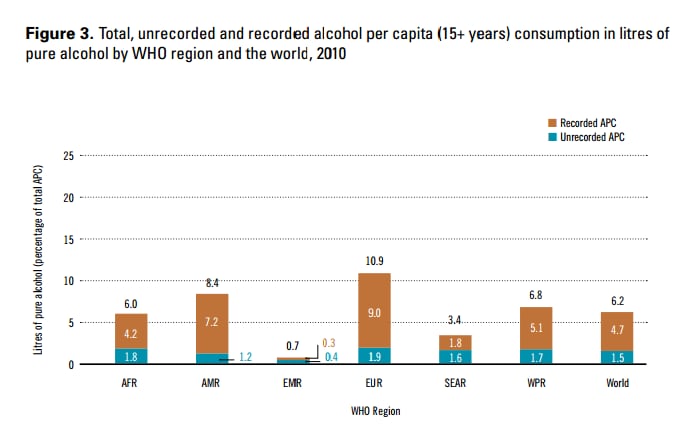Paul Skehan, director general, referred to last week’s World Health Organisation (WHO) Global Status Report on Alcohol and Health 2014 that suggested almost a quarter of all alcohol drunk worldwide is non-commercial - see the chart embedded in this article (see key at bottom) showing alcohol per capita (APC) consumption, which is taken from the new WHO report.
This is alcohol made, distributed and sold outside of lawful channels – whether it is smuggled into a given country or originally intended for industry or medical use.
“Whether the WHO estimates are correct or the real figure is 15%, 25% or 30%, the overall scale of the problem is massive,” Skehan said.
“The recent, tragic methanol poisoning in Kenya is there to remind us how important the issue is,” he added.

News reports from Kenya suggest that methanol was added to beer sold in Embu (about 100km northeast of Nairobi) and surrounding areas and, as of May 7, the death toll had reached 83.
Skehan said that spiritsEUROPE welcomed action by the OECD and some national governments to research this issue, with the spirits sector offering information and expertise to assist their efforts.
The trade body will help build a consensus on common definitions to describe the illicit alcohol market, a methodology to assess its size and the main drivers underlying the trade.
“The ambition is to build an easy-to-use research guide to achieve a degree of harmonization in future research, allowing aggregation of comparable data around the globe,” Skehan said.
“This data can then be used as the foundation to build appropriate public-private strategies to fight the proliferation of illicit alcohol,” he added.
The 2014 WHO report cites its own 2010 recommendations to reduce harmful use of alcohol in this area.
These include developing and strengthening systems to track and trace illicit alcohol, regulating sales of informally produced alcohol and bringing it into taxation systems.
Other WHO recommendations include ensuring co-operation and information exchange among national and international authorities to fight the illegal trade.
*AFR (WHO Africa Region)
AMR (WHO Region of the Americas)
EMR (WHO Eastern Mediterranean Region)
EUR (WHO European Region)
SEAR (WHO Southeast Asia Region)
WPR (WHO Western Pacific Region)
